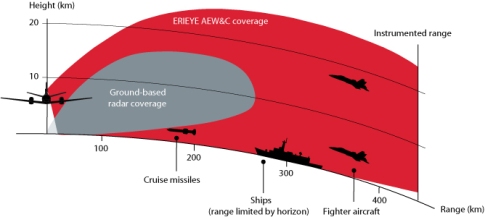- Joined
- Jul 25, 2017
- Messages
- 2,242
- Likes
- 1,961
You seem to be thinking that jammer completely masks the reflection. The reality is that the jammer creates a cloud of reflection because of which the receiver sees a large area of target. The farther the receiver, farther bigger the area. For example, a receiver at 200km may receive area as big as 10000 metre square as a target instead of 1 metre square area of the plane. It also makes the distance calculation error large. But the jammer does not hide the plane completely. The plane is only made difficult to be locked by missile.The thing is, they don't have to.
Stealth aircraft only need to detect IADS radar/AWACS before they are detected. And while AWACS have much more powerful radar, their RCS is also much bigger. One thing people always forget, you do not need to have a jammer more powerful than the radar to jam it. That why tiny jammer like RT-1489/ALE, BRITECLOUD, ALE-55, ALE-70 can work even though they are tiny and very weak . Because the jammer is not competing against the full output of the radar, it only competing against the reflection of the aircraft, which is a really small fraction of radar power and jammer signal only travel one way while radar signal have to travel 2 ways.
You might still think the much more powerful radar of AWACs will allow them to detect and target stealth aircraft first before they became the prey?. Well no, assuming the hypothetical AWACs has a radar with the average transmitted power of 1MW (ways more powerful than what available now), and the hypothetical stealth fighter has a radar with the average transmitted power of 3 kW (readily available in the market). That makes the AWACS radar 333.3 times more powerful than the stealth fighter radar. Unfortunately, that is still not enough, because common AWACs such as A-50 or E-3 have RCS around 20 dBsm or 100 m2, which is 100.000 times higher than a stealth aircraft. In short, if you put the number into at the equation that i gave earlier, it is highly impractical for AWACS to detect stealth aircraft first. (note: Pt= transmitting power of radar , σ = Radar cross section)

https://books.google.com.vn/books?i...bAhWEppQKHZIfDmoQ6AEIZTAG#v=onepage&q&f=false
Ok, so how about ground radar?. Practically, you can make them as powerful as you want, and because they are hiding within ground clutter so they would be the silver bullet against stealth aircraft?. Not really, since RWR exists. RWR can't replace radar in air to air role, because while they are totally silent and can give very accurate angular information, like all others passive system, against moving airborne target, they have very hard time quickly measuring the distance to target, or their velocity/heading/altitude. So a firing solution for BVR missiles can't be made quickly. On the other hand, ground targets have certain characteristics that makes geolocating them very easy. https://basicsaboutaerodynamicsandavionics.wordpress.com/2016/03/02/rwresm-and-passive-geolocation/
Another issue with ground radar is radar horizon, due to the curvature of the earth, there is a limitation on how far a normal radar can see depending on the altitude of the aircraft. Of course, there are OTH radar but they are highly inaccurate and also very massive, making them very easy target for cruise missiles

http://members.home.nl/7seas/radcalc.htm
P/s: modern cruise missile can fly very far

About stealth jet seeing AEWACS but not other way around due to jammers is also inaccurate. If jet can use jammers, so can AEWACS. So, it is evened out here.
Ground based radar is vulnerable to curvature of the earth and ground barriers like mountains. So, the ground based radar works in coordination with AEWACS. If the enemy jet is flying high and fast, ground radars will detect with ease. If the plane is low flying and slow, AEWACS will detect. If the plane is low flying, it is a threat to Ground radar but not a threat to AEWACS and if the plane is high flying it is a threat to AEWACS but not to ground radar






























